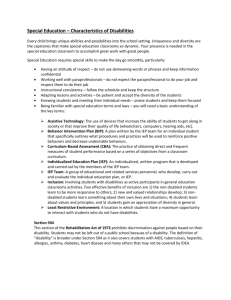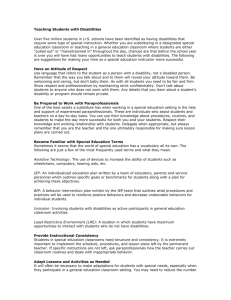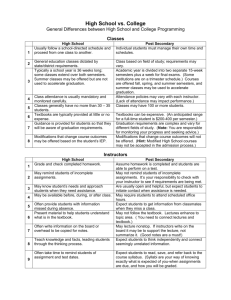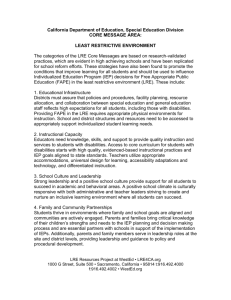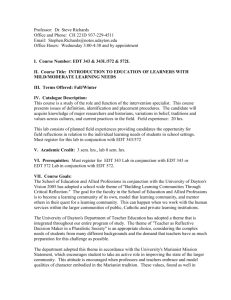syllabus- edt 575 - University of Dayton
advertisement
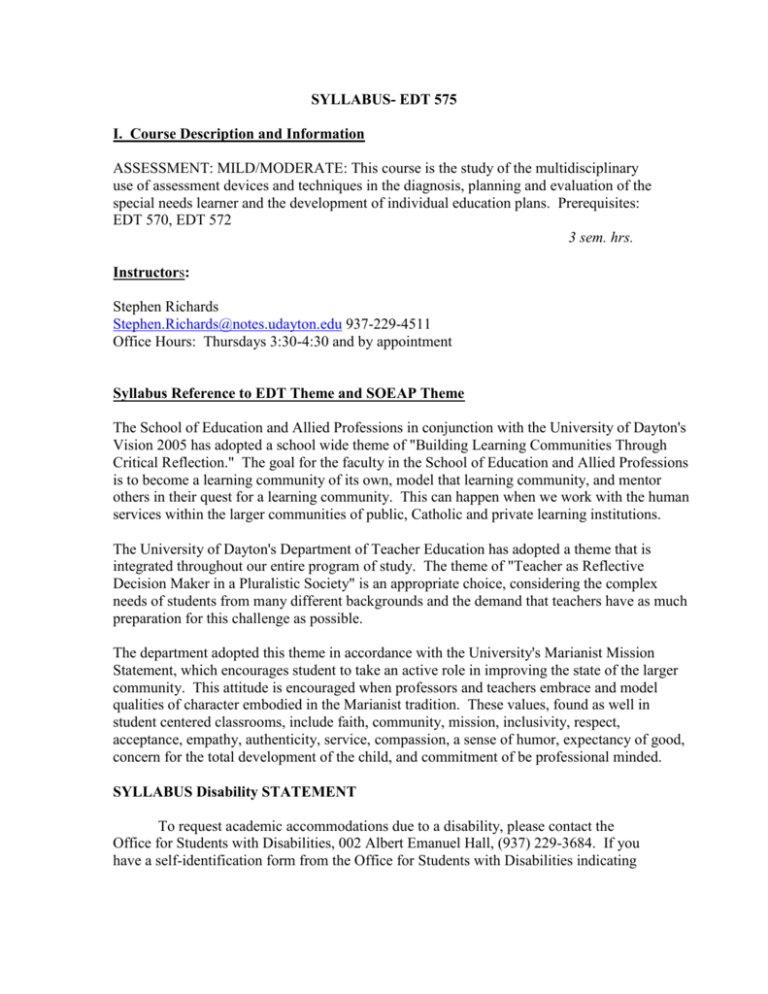
SYLLABUS- EDT 575 I. Course Description and Information ASSESSMENT: MILD/MODERATE: This course is the study of the multidisciplinary use of assessment devices and techniques in the diagnosis, planning and evaluation of the special needs learner and the development of individual education plans. Prerequisites: EDT 570, EDT 572 3 sem. hrs. Instructors: Stephen Richards Stephen.Richards@notes.udayton.edu 937-229-4511 Office Hours: Thursdays 3:30-4:30 and by appointment Syllabus Reference to EDT Theme and SOEAP Theme The School of Education and Allied Professions in conjunction with the University of Dayton's Vision 2005 has adopted a school wide theme of "Building Learning Communities Through Critical Reflection." The goal for the faculty in the School of Education and Allied Professions is to become a learning community of its own, model that learning community, and mentor others in their quest for a learning community. This can happen when we work with the human services within the larger communities of public, Catholic and private learning institutions. The University of Dayton's Department of Teacher Education has adopted a theme that is integrated throughout our entire program of study. The theme of "Teacher as Reflective Decision Maker in a Pluralistic Society" is an appropriate choice, considering the complex needs of students from many different backgrounds and the demand that teachers have as much preparation for this challenge as possible. The department adopted this theme in accordance with the University's Marianist Mission Statement, which encourages student to take an active role in improving the state of the larger community. This attitude is encouraged when professors and teachers embrace and model qualities of character embodied in the Marianist tradition. These values, found as well in student centered classrooms, include faith, community, mission, inclusivity, respect, acceptance, empathy, authenticity, service, compassion, a sense of humor, expectancy of good, concern for the total development of the child, and commitment of be professional minded. SYLLABUS Disability STATEMENT To request academic accommodations due to a disability, please contact the Office for Students with Disabilities, 002 Albert Emanuel Hall, (937) 229-3684. If you have a self-identification form from the Office for Students with Disabilities indicating that you have a disability, which requires accommodation, please present it to me so we can discuss the accommodations you might need in class. II. Course Objectives This course is designed to meet Standard 8 – Assessment - in the CEC Common Core and Individualized General Curriculum standards. These standards are also aligned with the Ohio standards for teacher preparation. Common Core Standards in Knowledge and Skills: Knowledge: CC8K1 Basic terminology used in assessment. CC8K2 Legal provisions and ethical principles regarding assessment of individuals. CC8K3 Screening, pre-referral, and classification procedures. CC8K4 Use and limitations of assessment instruments. CC8K5 National, state or provincial, and local accommodations and modifications. Skill: CC8S1 Gather relevant background information. CC8S2 Administer nonbiased formal and informal assessments. CC8S3 Use technology to conduct assessments. CC8S4 Develop or modify individualized assessment strategies. CC8S5 Interpret information from formal and informal assessments. CC8S6 Use assessment information in making eligibility, program, and placement decisions for individuals with exceptional learning needs, including those from culturally and/or linguistically diverse backgrounds. CC8S7 Report assessment results to all stakeholders using effective communication skills. CC8S8 Evaluate instruction and monitor progress of individual with exceptional learning needs. CC8S9 Develop or modify individualized assessment strategies. CC8S10 Create and maintain records. Individualized General Curriculum Knowledge and Skills: Knowledge: GC8K1 Specialized terminology used in the assessment of individuals with disabilities. GC8K2 Laws and policies regarding referral and placement procedures for individuals with disabilities. GC8K3 Types and importance of information concerning individuals with disabilities available from families and public agencies. GC8K4 Procedures for early identification of young children who may be at risk for disabilities Skill: GC8S1 Implement procedures for assessing and reporting both appropriate and GC8S2 GC8S3 GC8S4 GC8S5 problematic social behaviors of individuals with disabilities. Use exceptionality-specific assessment instruments with individuals with disabilities. Select, adapt and modify assessments to accommodate the unique abilities and needs of individuals with disabilities. Assess reliable method(s) of response of individuals who lack typical communication and performance abilities Monitor intragroup behavior changes across subjects and activities III. Topics to be covered: Due process rights; Legal provisions for assessment; Standardized testing; Formal and informal assessment (Types, limitation, bias); Basic assessment terminology; Diversity’s influence on assessment, application, and interpretation of scores; Pre-referral & referral procedures (IAT, IBMFE); Assessment/placement relationship; Assessment, diagnosis, and evaluation issues (Teaming, tracking progress, data from a variety of tools (i.e., academic, adaptive behavior, etc.), writing reports, reporting results orally); Alternative assessment techniques (portfolio, demonstration, etc.); Ethical practices. IV. Student Evaluation Criteria: A. Attendance – Every class is important. Students are expected to arrive on-time and to stay until class is dismissed. Absence in 2 classes (approx. 5.5 hrs.) may result in the student’s grade will be lowered one letter (i.e., From A to B; B to C). Three or more absences may result in failure. Two or more tardies or leaving early may be considered equivalent to one absence. B. Class reflections (30 pts.) - Students will respond to a critical reflection question(s) at periodic intervals. Reflections cannot be made-up for sessions missed. C. Assessment Instrument Presentations (50 points): Students will obtain a published norm-referenced, standardized assessment instrument from their school or the UD CMC (instructor will approve/assign instruments) and present the instrument to the class including: 1. Overview of the instrument, its purposes, for whom it is designed, and who may administer the instrument 2. A description and explanation of the items and administration procedures 3. A substantive demonstration of administration including how to score the instrument 4. A description and explanation of types of scores obtained and their meanings 5. Two students may work together on a single instrument but each will receive the same point total out of the possible 50 points for this presentation. D. Case Study & IEP (100 pts.) – The following guidelines are to be used: 1. Develop a case study. a. Identify a student for use as your case study. b. Develop a rationale for what you need to know about the student (e.g., based on age, grade level, disability or other relevant characteristics) c. Obtain information from parent(s) or teacher regarding background and other relevant data. d. Conduct an interest inventory/survey on your student. e. Administer at least one formal (norm-referenced, standardized), two informal (criterion referenced and/or teacher-made), and an assessment of vocational/career skills, behavioral skills, communication skills, or other appropriate instrument for your individual student. Other data may include class work, observational data, achievement test results, and any other appropriate source of information. Include a rationale for your choices for assessment procedures/instruments. Describe the results of your data gathering. 2. Develop an IEP Present Levels of Performance based on the data gathered. Develop 2 goals with a minimum of 3 objectives each based on present levels. Include your assessment procedures section of the IEP as well. 3. Develop progress monitoring forms/methods to be used with IEP goals/objectives. 4. Create a handout/narrative (3-4 pages) that includes a description of your student, the rationale for what you needed to know, what you learned about the student's strengths and needs, the IEP goals/objectives, and your progress monitoring forms. 5. Present your case study IEP to the class (20 points). E. Midterm & Final Examination (50 points each). The exam will revolve around supply answer items that require application and demonstration of knowledge, skills, and dispositions. Grade Scales and Policies A = 95% - 100% A- = 90-95% B+ = 87% - 89% B = 83-87% B- = 80-83% C = 70% - 79% F = Below 70%. 1. It is the student’s responsibility to study materials provided, read the text as directed and to come to class prepared. Lectures and in-class activities will clarify and expand materials and text. Powerpoint presentations are available on the website. 2. It is the student’s responsibility to notify the instructor if s/he is unable to attend class. 3. All assignments are due on the dates listed. Late assignments are lowered one letter grade per day late, unless special arrangements are made with the instructor. One-half letter grade will be deducted for any assignments not turned in at the beginning of class but submitted on the same day of class. No assignments will be accepted after the last class. 4. All assignments are expected to be of professional quality. Written materials should be free of grammatical errors, spelling errors, etc. Points will be deducted for these errors. V. Teaching Methods: Lecture/discussion, small group activities, demonstrations/presentations, in-class research. VI. Instructional Technology: Students are expected to word process documents/assignments. There may be websites and addresses you will be instructed to visit. The Ohio Dept. of Education website will be used in class to review specific rules and procedures for assessment in Ohio. VII. Field Experiences: 20 hours required and see Assignments for those requiring contact with public school students. VIII. Required Texts: Pierangelo, R., & Guiliani, G.A. (2006). Assessment in special education. Boston, MA: Allyn & Bacon. IX. Date of Syllabus Revision: January, 2006


